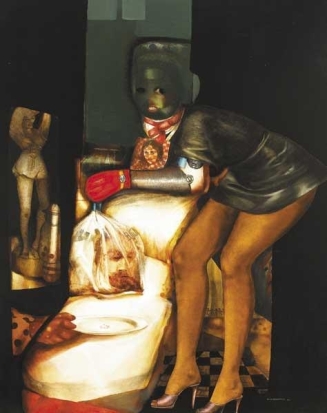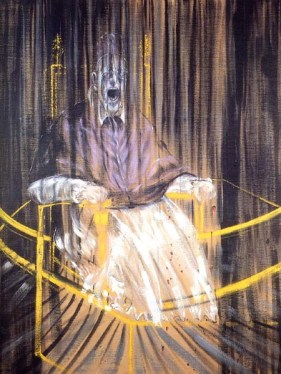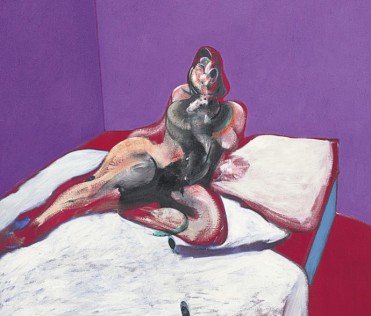 The Irish landscape artist, graphic designer and illustrator Norah McGuinness was born in County Derry, Northern Ireland. She studied drawing and fine art painting at the Metropolitan School of Art, Dublin (now the National College of Art & Design), the Chelsea Polytechnic, London, and then (on the advice of Mainie Jellett and Evie Hone) under the French artist André l’Hote, in Paris.
The Irish landscape artist, graphic designer and illustrator Norah McGuinness was born in County Derry, Northern Ireland. She studied drawing and fine art painting at the Metropolitan School of Art, Dublin (now the National College of Art & Design), the Chelsea Polytechnic, London, and then (on the advice of Mainie Jellett and Evie Hone) under the French artist André l’Hote, in Paris.
From France, McGuinness moved to London, becoming a member of the avant-garde London Group, and from 1937-39 she lived in New York. After America, she returned to settle in Dublin in 1940. She was elected an honorary member of the Royal Hibernian Academy (RHA) in 1957 but resigned in 1969.
Norah McGuinness executed vivid, highly coloured, flattened landscape paintings, (as well as still-life and portrait art) in a spontaneous style influenced in part by the colourist Fauvist movement and the artist Lhote. Although her painting remained figurative, her work reveals the Cubist influence of Lhote, and she was associated with the modern movement in Ireland. A founder member of the Irish Exhibition of Living Art (she succeeded Mainie Jellet as President in 1944), McGuinness (like Maurice MacGonigal) first showed at the RHA in 1924 and became an honorary member (HRHA) in 1957. She exhibited her paintings and designs in Ireland at the Victor Waddington Galleries and The Dawson Gallery, Dublin, and in London at the Wertheim Gallery. Together with Nano Reid, she represented Ireland in the 1950 Venice Biennale.
In addition to paintings, Norah McGuinness executed a large number of book illustrations, theatre sets and costume designs during her career. She also designed the sales windows of Altman’s in New York and Brown Thomas, Grafton Street for over thirty years.
 In 1968, a retrospective for Norah McGuinness artworks, numbering over 100, was staged by the Douglas Hyde Gallery, Trinity College Dublin. Another retrospective took place at the Frederick Gallery, Dublin, in 1996.
In 1968, a retrospective for Norah McGuinness artworks, numbering over 100, was staged by the Douglas Hyde Gallery, Trinity College Dublin. Another retrospective took place at the Frederick Gallery, Dublin, in 1996.
Her work appears in all the major Irish public collections – including: Hugh Lane Art Gallery, Dublin; Arts Council of Ireland; Arts Council of Northern Ireland; Ulster Museum, Belfast; Crawford Art Gallery, Cork; Irish Museum of Modern Art (IMMA), Dublin; National Gallery of Ireland, Dublin; University College Dublin; Waterford Art Gallery Collection; The Victoria and Albert Museum London; Meath County Council – as well as in several important overseas collections such as the Joseph H. Hirschorn collection in New York.
The auction record for a work by Norah McGuinness was set in 2006, when his landscape painting, entitled The Little Harvest, Mayo, was sold at James Adams, in Dublin, for €210,000.









 The Irish painter and designer Robert Ballagh was born in Dublin in 1943. A graduate of the Dublin Institute of Technology in architecture, he worked as an engineering draughtsman, a musician and a postman before taking up fine art painting full-time at the age of 24.
The Irish painter and designer Robert Ballagh was born in Dublin in 1943. A graduate of the Dublin Institute of Technology in architecture, he worked as an engineering draughtsman, a musician and a postman before taking up fine art painting full-time at the age of 24. Major exhibitions of his work have been staged in various European galleries, including Lund, Warsaw, Sofia and Dublin.
Major exhibitions of his work have been staged in various European galleries, including Lund, Warsaw, Sofia and Dublin. The Irish landscape painter James Craig was born in Belfast but spent his youth in the countryside of County Down. His Swiss mother came from a family of artists. Craig briefly attended Belfast College of Art where he studied drawing and fine art painting, cutting short his classes to become a largely self-taught painter of landscapes.
The Irish landscape painter James Craig was born in Belfast but spent his youth in the countryside of County Down. His Swiss mother came from a family of artists. Craig briefly attended Belfast College of Art where he studied drawing and fine art painting, cutting short his classes to become a largely self-taught painter of landscapes. Examples of his work may be seen in the collections of the Arts Council of Northern Ireland, The Armagh County Museum, The Hugh Lane Gallery Dublin, The Ulster Museum in Belfast and The National Gallery of Ireland. The Oriel Gallery mounted an exhibition of his work in 1978.
Examples of his work may be seen in the collections of the Arts Council of Northern Ireland, The Armagh County Museum, The Hugh Lane Gallery Dublin, The Ulster Museum in Belfast and The National Gallery of Ireland. The Oriel Gallery mounted an exhibition of his work in 1978. Francis Bacon (1909-1992) was an Irish figurative painter, influenced in his earlier years by Picasso and surrealism, whose unique expressionist style of painting, which emerged during the 1950s, featured pictures of people screaming or in pain, often portrayed inside bathrooms or cages. His tortured, nightmarish imagery projected a world of violent and shocking humanity. His talent as a modern expressionist artist blossomed alongside a shambolic personal life, marked by extreme sensuality, gambling and alcoholism. Even so, he was one of the most famous figures in Irish painting and a unique figure in the history of Irish art.
Francis Bacon (1909-1992) was an Irish figurative painter, influenced in his earlier years by Picasso and surrealism, whose unique expressionist style of painting, which emerged during the 1950s, featured pictures of people screaming or in pain, often portrayed inside bathrooms or cages. His tortured, nightmarish imagery projected a world of violent and shocking humanity. His talent as a modern expressionist artist blossomed alongside a shambolic personal life, marked by extreme sensuality, gambling and alcoholism. Even so, he was one of the most famous figures in Irish painting and a unique figure in the history of Irish art. In 1949, Bacon’s series of six paintings (Head I to Head VI) were exhibited at what was, in effect, a one-man show at the Hanover Gallery. with Study from the Human Body (1949) and Study for Portrait (1949) formed the core of the show with four other paintings by Bacon. His first solo show outside Britain was held in 1953 at Durlacher Brothers, New York, and his first retrospective was held at the Institute of Contemporary Arts, London, 1955.
In 1949, Bacon’s series of six paintings (Head I to Head VI) were exhibited at what was, in effect, a one-man show at the Hanover Gallery. with Study from the Human Body (1949) and Study for Portrait (1949) formed the core of the show with four other paintings by Bacon. His first solo show outside Britain was held in 1953 at Durlacher Brothers, New York, and his first retrospective was held at the Institute of Contemporary Arts, London, 1955. The Irish Cubist painter and stained glass artist Evie Hone was born in Dublin. One of the earliest abstract painters in the history of Irish art, she was the great-great-great granddaughter of Joseph Hone, a brother of the portrait painter Nathaniel Hone the Elder RA (1718-1784) and father of two other portraitists Horace Hone (1756-1825) and John Camillus Hone (1759-1836). Struck by infantile paralysis, Evie suffered from lameness the rest of her life.
The Irish Cubist painter and stained glass artist Evie Hone was born in Dublin. One of the earliest abstract painters in the history of Irish art, she was the great-great-great granddaughter of Joseph Hone, a brother of the portrait painter Nathaniel Hone the Elder RA (1718-1784) and father of two other portraitists Horace Hone (1756-1825) and John Camillus Hone (1759-1836). Struck by infantile paralysis, Evie suffered from lameness the rest of her life. From hereon, Evie’s main artistic preoccupation was with stained glass art. She first joined Sarah Purser’s studio – the stained glass co-operative An Túr Gloine – before setting up a studio of her own in Rathfarnham and becoming influenced by the great Harry Clarke.
From hereon, Evie’s main artistic preoccupation was with stained glass art. She first joined Sarah Purser’s studio – the stained glass co-operative An Túr Gloine – before setting up a studio of her own in Rathfarnham and becoming influenced by the great Harry Clarke. The contemporary abstract painter Felim Egan was born in Strabane, County Tyrone in 1952. He studied painting and drawing in Belfast and Portsmouth before attending the Slade School of Fine Art in London, after which he began exhibiting in the late 1970s. He also studied for 12 months at the British School at Rome in 1980 before returning to Dublin. One of Ireland’s most respected exponents of abstract art, his paintings are carefully built up in layers of thin colour with stone powder ground into the acrylic. His visual vocabulary includes the use of hieroglyphic-type motifs over monochromatic areas of colour, evoking long horizons, big skies and empty sands.
The contemporary abstract painter Felim Egan was born in Strabane, County Tyrone in 1952. He studied painting and drawing in Belfast and Portsmouth before attending the Slade School of Fine Art in London, after which he began exhibiting in the late 1970s. He also studied for 12 months at the British School at Rome in 1980 before returning to Dublin. One of Ireland’s most respected exponents of abstract art, his paintings are carefully built up in layers of thin colour with stone powder ground into the acrylic. His visual vocabulary includes the use of hieroglyphic-type motifs over monochromatic areas of colour, evoking long horizons, big skies and empty sands. Felim Egan’s work is represented in numerous collections both public and private, including those of the Irish Museum of Modern Art, Dublin; Hugh Lane Gallery; An Comhairle Ealaion/Tha Arts Council; Trinity College, Dublin; University College Dublin; Office of Public Works; Conrad Hotel; Irish Life, Dublin; Allied Irish Banks; Bank of Ireland; Aer Lingus; A & L Goodbody Ltd, Dublin; Gate Theatre; Kilkenny Castle, Kilkenny; Guinness Peat Aviation, Shannon; the Arts Council of Northern Ireland; Ulster Museum, Belfast; North West Arts Trust, Derry; Ardhowen Theatre, Enniskillen; Scottish National Gallery of Modern Art, Edinburgh; The British Library; Frtiz-Winter-Haus, Moderne Kunst Museum, Ahlen, Germany; Stedelijk Museum, Amsterdam; the European Parliament; Metropolitan Museum of Modern Art, New York; and others.
Felim Egan’s work is represented in numerous collections both public and private, including those of the Irish Museum of Modern Art, Dublin; Hugh Lane Gallery; An Comhairle Ealaion/Tha Arts Council; Trinity College, Dublin; University College Dublin; Office of Public Works; Conrad Hotel; Irish Life, Dublin; Allied Irish Banks; Bank of Ireland; Aer Lingus; A & L Goodbody Ltd, Dublin; Gate Theatre; Kilkenny Castle, Kilkenny; Guinness Peat Aviation, Shannon; the Arts Council of Northern Ireland; Ulster Museum, Belfast; North West Arts Trust, Derry; Ardhowen Theatre, Enniskillen; Scottish National Gallery of Modern Art, Edinburgh; The British Library; Frtiz-Winter-Haus, Moderne Kunst Museum, Ahlen, Germany; Stedelijk Museum, Amsterdam; the European Parliament; Metropolitan Museum of Modern Art, New York; and others.